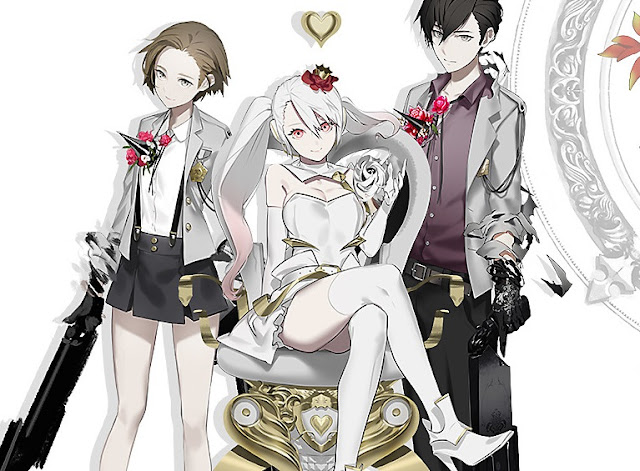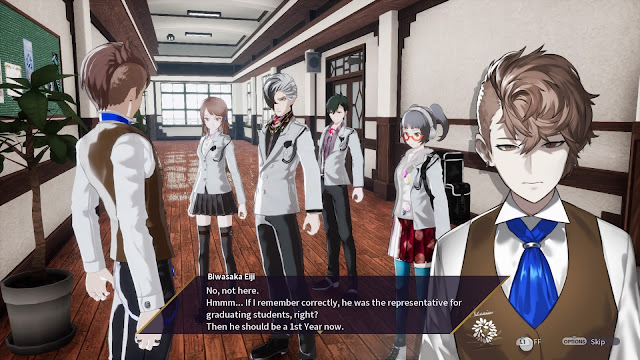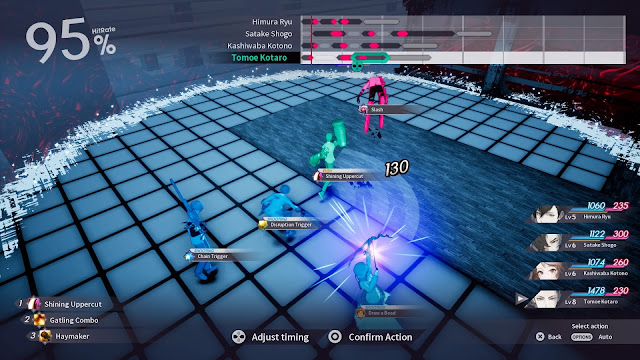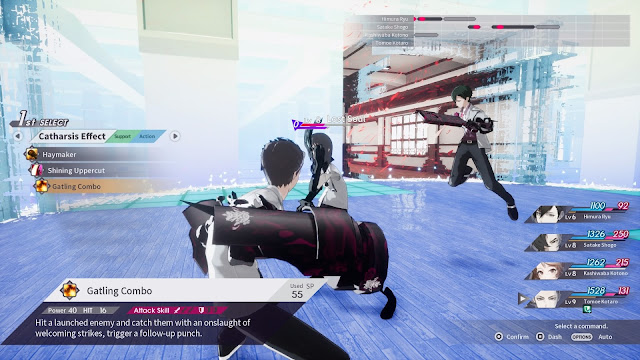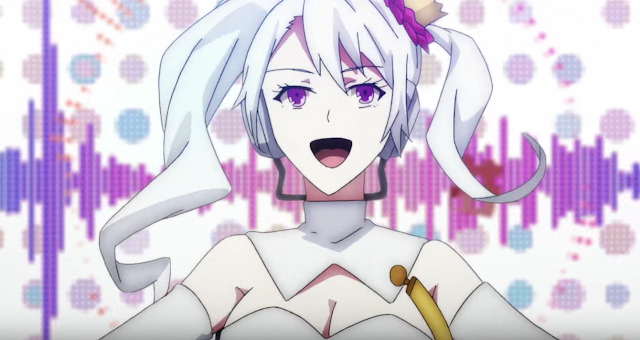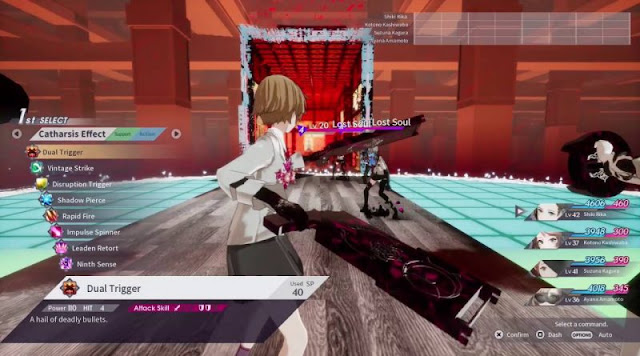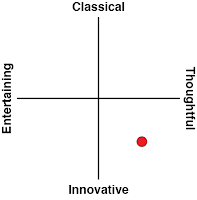Review by Matt S.
The original The Caligula Effect is the NieR (not Automata) of this generation. By that I mean that the game’s smart – genius smart – and has thematic and philosophical depth that few other games even come close to. But the packaging was a bit rough, so as the reviews rolled in, a shoddy framerate (I’ve never understood why that matters for a turn based JRPG), and a minimalist aesthetic combined to relegate it to the bottom of the “must play” pile. According to those that never bothered to look beyond its most superficial layer, The Caligula Effect was nothing but a weak pastiche of Persona.
It didn’t help that it was released on the PlayStation Vita, of course. That poor, beleaguered PlayStation Vita. But I digress. The Caligula Effect is back with an enhanced remaster treatment for the Nintendo Switch and PlayStation 4. And – surprise! – it’s still an absolutely brilliant philosophical thought bubble of a JRPG… and it’s probably going to put a lot of people off for the same reasons that its predecessor did.
The basic narrative works like this; you play as a team of people who are so dissatisfied with their existence in the real world that they’ve been pulled into a virtual universe, created by a virtual celebrity, μ (Mu). This world is a terrifying vision of a utopia. Yes, it’s a perfect haven of perpetual youth and nostalgic joy (hence why everyone are high school-aged, even though in the “real world” they’re actually adults), but in existing within it, people are also brainwashed out of awareness of the “real world”. The “heroes” of The Caligula Effect are all people that gained mental freedom from μ’s spell after realising that they’re better off facing their troubles back home. Sadly for them, their efforts to escape makes them a threat to the stability of the entire world. Because of that, another group of “aware” beings, who rather like their new digs and don’t particularly want to leave – musicians that specialise in virtual idol music – decide to turn all the blissfully unaware, brainwashed, “happy” people against this group in order to stop them.
Thematically, this game drives deep. The Caligula Effect is a heavy and rich thesis on the idea of supernormal stimuli, and what that can do to a culture and society. Supernormal stimuli are an exaggerated version of something that others perceive to be superior to the original thing, and because of that perceived superiority, the supernormal stimuli also elicits a more powerful response from the person experiencing the stimulus. The concern that some scholars have with supernormal stimuli is that they might start to alter our perceptions of reality, and in doing so, have a fundamental impact on the way we relate to the world, and the way society itself functions.
So, let’s talk about sex
Sex is an area where the impact of supernormal stimuli can be most keenly and overtly noted. In the TED video I linked to above, psychologist Donald Hoffman described an observed case study in which a beetle nearly went extinct because a certain beer bottle that was often discarded on the road acted as a “superior” version of what the beetle was looking for a mate. It doesn’t matter to the beetle that the beer bottle isn’t a “real” mate. Biologically, all it’s wired to do is seek out the “best”, and the supernormal stimuli is, as already noted, something that is perceived to be superior.
For all the intellectual superiority of humanity, science tells us that we’re every bit as susceptible to supernormal stimuli. Japan, for example, in having an abundance more supernormal stimuli in its culture than most other nations, has a plunging birth rate, and that has indeed been linked to the presence of such pervasive supernormal stimuli. Japanese artist, Hiroshi Sugimoto, created an exhibition of potential doomsday scenarios to humanity, and one such scenario was Hatsune Miku. In this scenario, the presence of Hatsune Miku replaces the needs of an ever-increasing number of people for interaction with other people, which leads to eventual societal collapse.
Yes, Hatsune Miku is a supernormal stimulant – she’s designed to be a highly idealised, “perfect” person-figure. And The Caligula Effect’s μ is explicitly based on her. When I interviewed the director of the game – Yamanaka Takuya – at last year’s Tokyo Game Show, he said that Miku’s elevation to a bona fide idol – the object of worship within Japanese sub-cultures – fascinated him, and was the driving inspiration behind μ.
“In Japanese spirituality and folklore, there’s a common theme in the concept of humans fighting against gods and defeating them,” Yamanaka said in the interview.
“It was an appealing narrative theme because it’s something that was very taboo, of course, and as such a lot of people found the idea fascinating. But lately, people in the current era, they don’t believe in gods anymore, and they’re moving more towards worshiping idols or famous TV stars. People are more inclined to believe in them instead of a god.
“So we can see that Hatsune Miku is a kind of saviour and being to believe in for the young people in the current era. If you take someone like her and actually defeat her… well, that would be the equivalent of god killing of this era. That’s how μ came about.”
And so, while The Caligula Effect is a story of fighting back against supernormal stimuli, it certainly paints a picture of, and makes an observation on, the kind of alternative realities that more and more people are finding themselves drawn into.
All of this is told quite brilliantly through the game. In comparison to the narrative indulgences of something like Persona, The Caligula Effect is more minimalist in its storytelling, but it gets its point across with an efficiency and elegance that is quite enjoyable. At a time where JRPGs are being pushed to reach arbitrary lengths at the expense of their integrity as narrative (yes, Persona 5, I do mean you), The Caligula Effect’s efficiency – while still offering a full-length and obviously deep narrative – is truly refreshing.
The anti-Persona
I’ve mentioned Persona a few times previously, because superficially, the narrative structure of both The Caligula Effect and Persona titles is similar; you take control of an eclectic group of people, and then help guide them through dungeons and boss battles that, in one abstract way or another, represent a difficulty that the character is facing within themselves.
But The Caligula Effect is different, because what motivates the characters is different. This is, fundamentally, a selfish bunch of people, which do provide an existential threat to the rest of the world around them. Where the heroes of each Persona title has been interested in doling out some form of justice or “goodness,” in The Caligula Effect, they just want to get home… and they’re not really big on their allies, either. Where Persona would spend dozens of hours carefully describing a deepening bond between characters, The Caligula Effect is more keen on pointing out that the only reason that they’re together at all is that they’ve got a common goal.
There’s an academic coldness to the characters, in a way that mirrors the white space-dominated environments and clinical approach to storytelling. Overdose does let you make the decision to side with the “villains”, which is an all-new narrative addition to this version of the game, and does more than enough to change up the context of the game enough that people who played it on PlayStation Vita really do need to give it a second spin. Regardless of the path you take, I wouldn’t say that your teammates in The Caligula Effect are impossible to sympathise with, but I suspect it will be more difficult for people to warm to them than in Persona. It’s just important to keep in mind that this is deliberate, and The Caligula Effect is, for all its superficial similarities to its peer, in many ways the anti-Persona.
Regardless of what you think of the characters, their designs are quite impressive. For example, insofar as the “heroes” are concerned, each has on their body some kind of flower motif, that really comes to life when the character enters combat. It’s an impressive touch for the “heroes” because these vaguely sinister designs remind you that you’re not in control of a force for pure good, and the potential devastation that these “heroes” can bring on the virtual world goes far enough to be a moral quandary. At the same time, the flowers in some meaningful way represent the backstory of the characters, and the darkness inside them that they need to come to deals with. And, if you choose to side with the musicians instead, there are a separate set of subtle details about them that also help to flesh them out (I’m trying really hard not to give this side of things away here, because the addition of the magicians narrative route is so filled with surprises and thought experiments that it needs to be experienced fresh).
The Caligula Effect looks simple, thanks to that minimalist nature, and the consistent use of white-dominated aesthetic. Colour is used sparingly, but for deliberate effect, helping to reinforce the alien nature of the world, and to distinguish it from reality. I’m always going on about how much I wish the games industry could break away from the idea that “realism” is the ultimate goal of the graphics team, and one of the reasons that I love The Caligula Effect so much is that it delivers the kind of vision for video games as an artistic vision that I’d like to see become more commonplace.
Yes, yes, it plays well too
The Caligula Effect is best played on the hardest difficult setting. Not because I believe in some nonsense like games needing “challenge” in order to feel rewarding, but simply because the game has one of the most unique combat systems we’ve ever seen, and it’s only on the highest difficulty setting that you’ll even get to properly use it.
Because this is a game about music idols, with musicians as antagonists, and one of the best soundtracks you’ll ever hear (with much of the music contributed by real-world vocaloid specialists), The Caligula Effect keeps its theme consistent by also offering a combat system that is deeply musical. Given that it’s also a turn-based JRPG, it’s a concept that might be difficult to visualise, but in practice it works. Breathtakingly well.
You can take four characters into battle, each with their own set of abilities – some might counter enemy attacks, others might launch them into the air, while still others might knock them into the ground. Once you’ve finished inputting all your character’s attacks, the turn plays out in real time (with the enemy attacks too), and once everyone’s had their turn, you can issue a new set of orders. The trick to the battle system is to time the attacks from each party member to capitalise on what the others are doing. So, for example, using one character’s “do extra damage to an opponent that is in the air” after another character has launched that opponent into the air.
Before you confirm the round’s worth of attacks, you can do some further tweaking to maximise the rhythm of your party’s attacks. Attacks are visualised on screen in the same way that music would be in an audio editing program, and you can shift the timing of attacks back and forward, to come before or after other character’s attacks. Throughout the whole process you’re also given a visual guide to how the round’s attacks might play out (taking into account what the enemy is also doing), so there’s a lot of strategy involved in fine-tuning the order of attacks, and figuring out precisely what you need to do in any given round.
Sadly on the lower difficulty levels none of this is necessary with common enemies. All you need to do with those is “button mash” the default attack options and the enemies will fall down easily. Within any given area there are a couple of really difficult opponents to deal with, and boss battles require a couple of rounds to work through, but it’s only on the highest difficulty setting that you’ll get to enjoy the maximum strategic depth that this combat system offers on a frequent basis.
The only other issue I have with The Caligula Effect is its mission structure. The game loves forcing you to wander back and forth across each of its levels over and over again when following its breadcrumb trail. On the levels where the corridors are wider this is less of an issue, because you’ll be able to avoid a huge number of the enemies along the way by running around them. When levels have smaller corridors, it can feel like such a grind to be doing yet more combat across an environment that you’ve already worn deep tread marks into.
There’s also a full social system in place for just about every character in the game. When they’re not currently monsters (by defeating them you can return them to normal), you can run up to just about every character and build a relationship with them by talking to them – there’s something like 500 in total. Eventually you’ll get all kinds of sub-stories and additional detail out of the game through this system, but I’ve always found it to be a little clumsy in execution. Still worth playing around with, but it’s never quite tickled my “completionist” itch.
That being said, The Caligula Effect progresses at a fast enough clip that, for the second time over, I haven’t wanted to put it down. Yes, it comes across as a little dry and academic, so I would never expect this to find a mainstream audience, even now that it has been liberated from the PlayStation Vita and onto consoles that are popular in the mainstream. However, it’s also an unapologetically smart and thoughtful game, one that’s happy to be philosophical, and one that’s willing to make you work to truly dig into what makes it so wonderful. It’s like a work of literature in that way, as opposed to a page-turning novel, and it commands (and deserves) respect for that.
– Matt S.
Editor-in-Chief
Find me on Twitter: @digitallydownld
Please help keep DDNet running: Running an online publication isn’t cheap, and it’s highly time consuming. Please help me keep the site running and providing interviews, reviews, and features like this by supporting me on Patreon. Even $1/ month would be a hugely appreciated vote of confidence in the kind of work we’re doing. Please click here to be taken to my Patreon, and thank you for reading and your support!

